2009 Exhibitions and Events
Carolyn Wren
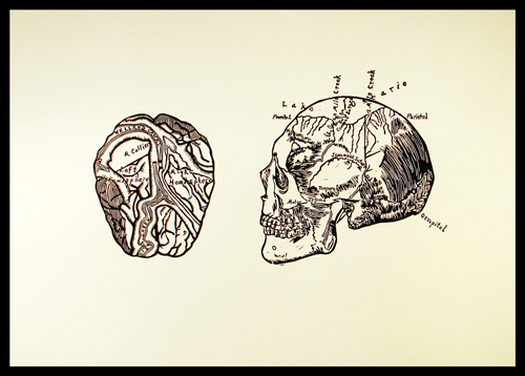
untitled relief print on Somerset paper, 30 in x 43.5 in / 76 cm x 110.5 cm, 2008
Territories
January 16 - February 2, 2009
In this new print series, I reference the relationship of the landscape to the body. I look at patterns, systems of external order, and structures. The cultural meanings implicit in the language of mapping and the body create new mythologies and become a personal and private mapping of identity. Each abstract shape marks the contours of the body. The maps layered on the images from Grey’s Anatomy cite the relationship of place and time on the body as it makes reference to the cartography of the body itself. There is a slippage in the signs; the signifiers loose relationship with the signified as the two systems collide. Ambiguity blurs the meaning as the fissures and hemispheres of the body can be read as ravines and the spine and teeth as creeks and waterways of the map. The signs conflate and take on new meaning. Carolyn Wren
January 16 - February 2, 2009
In this new print series, I reference the relationship of the landscape to the body. I look at patterns, systems of external order, and structures. The cultural meanings implicit in the language of mapping and the body create new mythologies and become a personal and private mapping of identity. Each abstract shape marks the contours of the body. The maps layered on the images from Grey’s Anatomy cite the relationship of place and time on the body as it makes reference to the cartography of the body itself. There is a slippage in the signs; the signifiers loose relationship with the signified as the two systems collide. Ambiguity blurs the meaning as the fissures and hemispheres of the body can be read as ravines and the spine and teeth as creeks and waterways of the map. The signs conflate and take on new meaning. Carolyn Wren
Mark Elliott
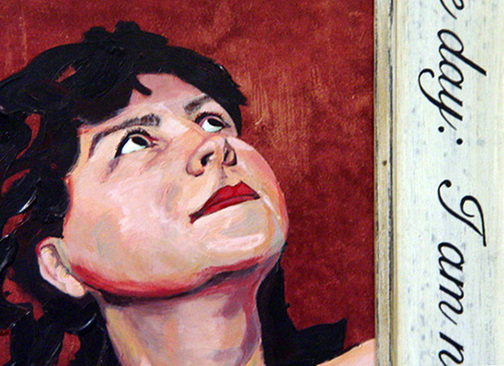
I Am (detail), mixed media, 42 in X 27.75 in / 106.5 cm X 70.5 cm, 2003/2009
re•e•mer•ging
February 14 - March 2, 2009
For many years now, I have been working on conceptually based pieces where images were researched, symbolism investigated, a fascination with ambiguities and dichotomies explored, and drawings and/or maquettes constructed, adjusted, and reworked, either physically or mentally. Through this long, arduous and sometimes stagnating process a work of art emerged.
This exhibition is composed of two sets of work. Two of the paintings are part of a series that was begun early in the millennium and was based around philosophy and spirituality. The final painting in this series speaks of the relationship between the artist, intuition, and a connection to the Divine. It became clear to me that the ideas presented in this work were in direct conflict with the manner in which I have produced art for sometime now. This realization has left me vowing to work more intuitively. The remaining paintings in the show are the recent result of this change.
For me, this exhibition is not only about re-emerging into the world of Public Art, which I had chosen to leave over twenty years ago, but a re-emergence from the shackles of pre-planned, banal image-making. My best works were always completed intuitively, while in the moment.
Mark F. Elliott
St. Catharines Standard Review
February 14 - March 2, 2009
For many years now, I have been working on conceptually based pieces where images were researched, symbolism investigated, a fascination with ambiguities and dichotomies explored, and drawings and/or maquettes constructed, adjusted, and reworked, either physically or mentally. Through this long, arduous and sometimes stagnating process a work of art emerged.
This exhibition is composed of two sets of work. Two of the paintings are part of a series that was begun early in the millennium and was based around philosophy and spirituality. The final painting in this series speaks of the relationship between the artist, intuition, and a connection to the Divine. It became clear to me that the ideas presented in this work were in direct conflict with the manner in which I have produced art for sometime now. This realization has left me vowing to work more intuitively. The remaining paintings in the show are the recent result of this change.
For me, this exhibition is not only about re-emerging into the world of Public Art, which I had chosen to leave over twenty years ago, but a re-emergence from the shackles of pre-planned, banal image-making. My best works were always completed intuitively, while in the moment.
Mark F. Elliott
St. Catharines Standard Review
Terra Incognita
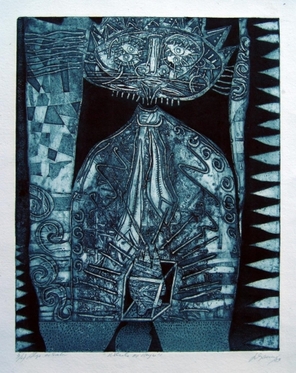
Contemporary Cuban Artists in Niagara Falls
José Armando Medina Sanabia, Jorge Juan Knight Vera, Israel Tamayo Zamora, Gregorio Pérez Escobar,Miguel Angel Lobaina Borges, Jorge Luis Chávez Gamez, Vivian Lozano Caballero, Orestes Larios Zaak
March 7 - 31, 2009
Opening Reception: Saturday, March 7th, 7 pm
Artist Talk: Friday, March 20th, 7 pm
Terra Incognita brings together the work of some of the most prestigious contemporary artists living in Cuba today, representing three artistic generations who produce paintings and limited editions of original print media. The “unknown territory” of Terra Incognita is expressed through the use of rich symbols, metaphors, and creative techniques that are uniquely Cuban in style and execution. The depth of each artist’s work presents the North American audience with new and complex insights into contemporary Cuban culture.
While these artists share the same land, they have diverse life experiences and express dissimilar visions of Cuba, an island country full of things to say to the outside world. The techniques employed are visceral and organic, providing the viewer with tactile references to understanding the works in the exhibition. Each artist in the show is a recipient of national and international awards, and as a group they are collaborating in an exchange between the CRAM Collective of St. Catharines and Taller Cultural in Santiago de Cuba.
The Artist Talk by Jose Armando on March 20th will introduce the work of the artists from Taller Cultural in a slide and video presentation. Taller Cultural in Santiago de Cuba is an art organization with printmaking, sculpture, and painting studios, as well as facilities for teaching and community based projects. Well experienced with sponsoring international mural, ceramic, and printmaking events, the artists of Taller Cultural actively develop art exchanges with many countries.
This show is a unique introduction to the artists in the Cuban exchange project with CRAM. Designed to strengthen the cultural dialogue between Cuban and Canadian artists, an exhibition and artist residencies will be presented by r@allery in October 2009. Proceeds from the sale of the original works of art in Terra Incognita will enable the artists to travel to Niagara for the CCGB Opening Reception and the presentation of public events while in Niagara Falls this coming October.
José Armando Medina Sanabia, Jorge Juan Knight Vera, Israel Tamayo Zamora, Gregorio Pérez Escobar,Miguel Angel Lobaina Borges, Jorge Luis Chávez Gamez, Vivian Lozano Caballero, Orestes Larios Zaak
March 7 - 31, 2009
Opening Reception: Saturday, March 7th, 7 pm
Artist Talk: Friday, March 20th, 7 pm
Terra Incognita brings together the work of some of the most prestigious contemporary artists living in Cuba today, representing three artistic generations who produce paintings and limited editions of original print media. The “unknown territory” of Terra Incognita is expressed through the use of rich symbols, metaphors, and creative techniques that are uniquely Cuban in style and execution. The depth of each artist’s work presents the North American audience with new and complex insights into contemporary Cuban culture.
While these artists share the same land, they have diverse life experiences and express dissimilar visions of Cuba, an island country full of things to say to the outside world. The techniques employed are visceral and organic, providing the viewer with tactile references to understanding the works in the exhibition. Each artist in the show is a recipient of national and international awards, and as a group they are collaborating in an exchange between the CRAM Collective of St. Catharines and Taller Cultural in Santiago de Cuba.
The Artist Talk by Jose Armando on March 20th will introduce the work of the artists from Taller Cultural in a slide and video presentation. Taller Cultural in Santiago de Cuba is an art organization with printmaking, sculpture, and painting studios, as well as facilities for teaching and community based projects. Well experienced with sponsoring international mural, ceramic, and printmaking events, the artists of Taller Cultural actively develop art exchanges with many countries.
This show is a unique introduction to the artists in the Cuban exchange project with CRAM. Designed to strengthen the cultural dialogue between Cuban and Canadian artists, an exhibition and artist residencies will be presented by r@allery in October 2009. Proceeds from the sale of the original works of art in Terra Incognita will enable the artists to travel to Niagara for the CCGB Opening Reception and the presentation of public events while in Niagara Falls this coming October.
Krys Elliott
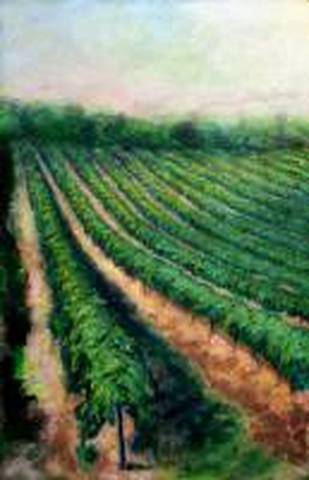
Niagara Ridge, acrylic on canvas, 95cm x 145 cm, 2008
Passage and Recall
April 11 - 29, 2009
As a child growing up in Niagara, I spent seemingly endless summers at my grandparents’ farm, at first watching my parents and grandparents toil in the orchards and vineyards and later working there myself. That farm no longer exists, having been swallowed up by urban sprawl, but the recollection of that ever-changing landscape, the emotions it evoked, and the hardship it created remains with me to this day.
I left Niagara intending to never return; first traveling to western Europe, then to western Canada, and finally, to the east coast. For some reason, I have always been drawn back to this place, and its haunting rhythmic landscape.
The paintings in this exhibition, while inspired by specific sites within Niagara, are not imitations of those locations, but rather “recollections.” They are moments, edited by memory, filtered by recall and transformed by the passage of time. Through the years, I have chosen to explore other mediums and subject matter, both figuratively and conceptually, but each time I return to the Niagara landscape looking for more than the mere sum of form, colour and texture. The landscape has become a measure of growth for me. It has become my meter.
April 11 - 29, 2009
As a child growing up in Niagara, I spent seemingly endless summers at my grandparents’ farm, at first watching my parents and grandparents toil in the orchards and vineyards and later working there myself. That farm no longer exists, having been swallowed up by urban sprawl, but the recollection of that ever-changing landscape, the emotions it evoked, and the hardship it created remains with me to this day.
I left Niagara intending to never return; first traveling to western Europe, then to western Canada, and finally, to the east coast. For some reason, I have always been drawn back to this place, and its haunting rhythmic landscape.
The paintings in this exhibition, while inspired by specific sites within Niagara, are not imitations of those locations, but rather “recollections.” They are moments, edited by memory, filtered by recall and transformed by the passage of time. Through the years, I have chosen to explore other mediums and subject matter, both figuratively and conceptually, but each time I return to the Niagara landscape looking for more than the mere sum of form, colour and texture. The landscape has become a measure of growth for me. It has become my meter.
Melanie MacDonald
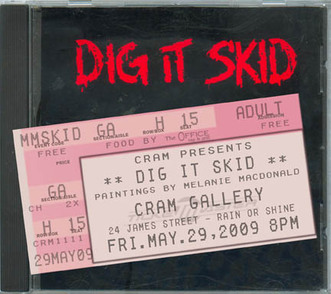
Dig it Skid
May 29 - June 24, 2009
Call someone a ‘skid’ and you’re using a piece of Canadian slang that has an imprecise definition. For me, they were the kids I hung out with in the ‘smoke hole’ at my high school—located next to the tech wing.
Their character seemed to be defined by class and adolescent angst. There was self-defeating nihilism but it was balanced with an unwavering faith in partying. There were other hallmarks too: a love of heavy metal music, drugs and alcohol, and a ‘fuck-you attitude’ that was both playful and genuine.
I’ve made these paintings from found photographs. These aren’t people I know directly. Their portraits are a re-consideration and celebration of a distinctive coming of age, masculinity, rebellion, and the dubious difference between low and high brow.
This series of paintings takes as its title a scrawl of graffiti on a rock-cut along the Trans Canada Highway near Sudbury.
May 29 - June 24, 2009
Call someone a ‘skid’ and you’re using a piece of Canadian slang that has an imprecise definition. For me, they were the kids I hung out with in the ‘smoke hole’ at my high school—located next to the tech wing.
Their character seemed to be defined by class and adolescent angst. There was self-defeating nihilism but it was balanced with an unwavering faith in partying. There were other hallmarks too: a love of heavy metal music, drugs and alcohol, and a ‘fuck-you attitude’ that was both playful and genuine.
I’ve made these paintings from found photographs. These aren’t people I know directly. Their portraits are a re-consideration and celebration of a distinctive coming of age, masculinity, rebellion, and the dubious difference between low and high brow.
This series of paintings takes as its title a scrawl of graffiti on a rock-cut along the Trans Canada Highway near Sudbury.
Tobey C. Anderson & Alan Flint
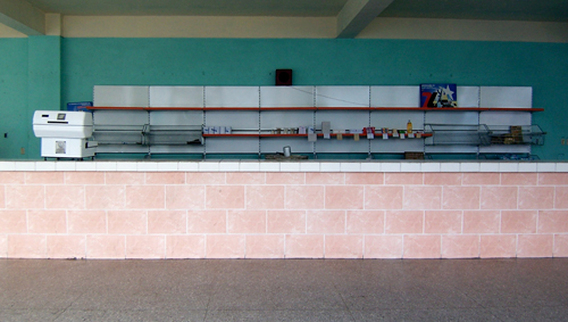
Reflections
New work. Santiago de Cuba. Print media. Photos. Video.
June 26 - July 19, 2009
Alan Flint and Tobey C. Anderson return from residencies in Santiago de Cuba reflecting on the notion of syncretism in their cross-cultural exchange. Choosing not to live in a typical tourist fashion while in Cuba, Flint and Anderson experienced life from a vantage point of being with the people and new found friends in the artistic community of Taller Cultural, a multi-disciplinary workshop of printmakers, painters, sculptors, and ceramic artists. Their interest in syncretism stems from an introduction to the unique religious belief of Santeria and how it has influenced a unique and original surrealist approach to art and culture.
New work. Santiago de Cuba. Print media. Photos. Video.
June 26 - July 19, 2009
Alan Flint and Tobey C. Anderson return from residencies in Santiago de Cuba reflecting on the notion of syncretism in their cross-cultural exchange. Choosing not to live in a typical tourist fashion while in Cuba, Flint and Anderson experienced life from a vantage point of being with the people and new found friends in the artistic community of Taller Cultural, a multi-disciplinary workshop of printmakers, painters, sculptors, and ceramic artists. Their interest in syncretism stems from an introduction to the unique religious belief of Santeria and how it has influenced a unique and original surrealist approach to art and culture.
La IIave / The Key
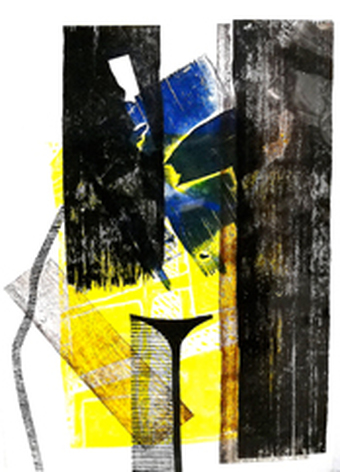
Woodblock, Jorge Knight
Selected Small Paintings and Prints
from the Cultural Factory "Luís Díaz Oduardo"
Santiago de Cuba
September 18 - October 7
Artist-in-residence: Jorge Luis Chávez Games
+CRAMPress Innaugural Opening
The Opening also marks the reveal of CRAMPress, Canada's newest and smallest print workshop. Specializing in small format relief printing, the workshop will be co-ordinated by the CRAMPress International Print Master, José Armando Medina.
CRAM has developed an on-going relationship of exchange projects with Taller Cultural "Luís Díaz Oduardo" in Santiago de Cuba. In April and May CRAM artists were in residence and participated with Cuban counterparts in the exhibition "Dos Grupe de Siete (+2)" at Galeria Oriente in the historic city centre of Santiago de Cuba. Now the Cubans join us in Niagara.
The "Cultural Factory" was founded in Cuba's second largest city in 1976. Since the 1980's the Taller Cultural "Luís Díaz Oduardo" has brought together artists, critics, and researchers interested in the study, creation, and dissemination of the Visual Arts. Unique in Cuba by its structure, this cultural factory concentrates on techniques and experimentation in the plastic art disciplines of printmaking, painting, sculpture, and ceramics. The Taller Cultural gathers and disseminates documentation for research and exchange with other institutions in Cuba and abroad.
The 10 senior, mid-career, and emerging artists presented at CRAM have an array of national and international awards, and they are engaging representatives of the contemporary cultural fabric of Santiago de Cuba. Recognized for their exceptional craftsmanship and prominent in this selection of work is the colograph, the print medium of choice at the Cultural Factory, as well as examples of stone lithography and painting. The imagery is steeped in symbolism and metaphor. There are elements in the work that reflect the influence of an original Cuban Surrealism pre-dating European Surrealism that grew out of the synchronism of the Santeria religion.
Taller Cultural organizes the international events Terra-cotta (ceramics) May 14 - 31 and Internos (murals) January 5 - 27. This December the first meeting of international print artists will take place to establish annual printmaking workshops.
Artist in the exhibition: Jorge Knight, Israel Tamyo Zamora, Vivian Lozano Caballero, Julio Cesar Carmenate, Joel Aguilera Tamayo, Justinio Reyes Rodríguez, Mauricio Reyes Aranda, Joaquin Bolivar, Listado de Obras, Jorge Luis Chavez, Miguel Angel Lobaina Borgues
Related Events:
Popeye's Golden Theory
Cuban Punk Direct from Habana, Cuba
Visuals by Marinko with Wax Mannequin & Alan Flint
September 10th, 10 pm
Paintings by Cuban Surrealist
Jorge Luis Chávez Games
CRAMplex
Dos Grupos de Siete (+2) / Two Groups of Seven (+2)
CRAM-Cuba CCGB Exchange Exhibition
October 9 - 26
Reception: Oct 9th, 6 - 9 pm
Chateau Park Museum & Art Gallery
Niagara Falls, Ontario
CRAM International Print Symposium
Niagara Artists' Centre
October 24
Visiting Print Artists: Vivian Lozano Caballero, Israel Tamayo Zamora, Miguel Angel Lobaina Borgues (Cuba), Prof. Augustus Mazzocca (USA), Deborah Carruthers (Montréal, Québec), Alan Flint (Hamilton, Ontario)
from the Cultural Factory "Luís Díaz Oduardo"
Santiago de Cuba
September 18 - October 7
Artist-in-residence: Jorge Luis Chávez Games
+CRAMPress Innaugural Opening
The Opening also marks the reveal of CRAMPress, Canada's newest and smallest print workshop. Specializing in small format relief printing, the workshop will be co-ordinated by the CRAMPress International Print Master, José Armando Medina.
CRAM has developed an on-going relationship of exchange projects with Taller Cultural "Luís Díaz Oduardo" in Santiago de Cuba. In April and May CRAM artists were in residence and participated with Cuban counterparts in the exhibition "Dos Grupe de Siete (+2)" at Galeria Oriente in the historic city centre of Santiago de Cuba. Now the Cubans join us in Niagara.
The "Cultural Factory" was founded in Cuba's second largest city in 1976. Since the 1980's the Taller Cultural "Luís Díaz Oduardo" has brought together artists, critics, and researchers interested in the study, creation, and dissemination of the Visual Arts. Unique in Cuba by its structure, this cultural factory concentrates on techniques and experimentation in the plastic art disciplines of printmaking, painting, sculpture, and ceramics. The Taller Cultural gathers and disseminates documentation for research and exchange with other institutions in Cuba and abroad.
The 10 senior, mid-career, and emerging artists presented at CRAM have an array of national and international awards, and they are engaging representatives of the contemporary cultural fabric of Santiago de Cuba. Recognized for their exceptional craftsmanship and prominent in this selection of work is the colograph, the print medium of choice at the Cultural Factory, as well as examples of stone lithography and painting. The imagery is steeped in symbolism and metaphor. There are elements in the work that reflect the influence of an original Cuban Surrealism pre-dating European Surrealism that grew out of the synchronism of the Santeria religion.
Taller Cultural organizes the international events Terra-cotta (ceramics) May 14 - 31 and Internos (murals) January 5 - 27. This December the first meeting of international print artists will take place to establish annual printmaking workshops.
Artist in the exhibition: Jorge Knight, Israel Tamyo Zamora, Vivian Lozano Caballero, Julio Cesar Carmenate, Joel Aguilera Tamayo, Justinio Reyes Rodríguez, Mauricio Reyes Aranda, Joaquin Bolivar, Listado de Obras, Jorge Luis Chavez, Miguel Angel Lobaina Borgues
Related Events:
Popeye's Golden Theory
Cuban Punk Direct from Habana, Cuba
Visuals by Marinko with Wax Mannequin & Alan Flint
September 10th, 10 pm
Paintings by Cuban Surrealist
Jorge Luis Chávez Games
CRAMplex
Dos Grupos de Siete (+2) / Two Groups of Seven (+2)
CRAM-Cuba CCGB Exchange Exhibition
October 9 - 26
Reception: Oct 9th, 6 - 9 pm
Chateau Park Museum & Art Gallery
Niagara Falls, Ontario
CRAM International Print Symposium
Niagara Artists' Centre
October 24
Visiting Print Artists: Vivian Lozano Caballero, Israel Tamayo Zamora, Miguel Angel Lobaina Borgues (Cuba), Prof. Augustus Mazzocca (USA), Deborah Carruthers (Montréal, Québec), Alan Flint (Hamilton, Ontario)
Dos Grupos de Siete (+2) / Two Groups of Seven (+2)
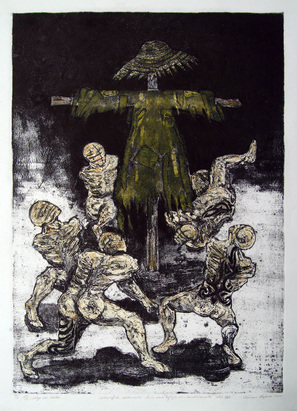
Vivian Lozano, colographia, 2009
CRAM-Cuba Exchange Exhibition between the Santiago de Cuba Cultural Factory "Luis Diaz Oduardo" and CRAM Collective
Mount Carmel
Chateau Park Museum & Art Centre - Niagara Falls, Canada
October 9 - 26, 2009
The Cuban and Canadian artists in this exhibit exchange have attempted to address the environment as a broad but common starting point for their work. All the artists come with the understanding that ecological systems are dense, complex lattice-works of connections and relationships. The relationship that humankind now has with the natural world -- our place in the planet’s global ecosystem -- is governed by and further complicated by economic and political systems. In Canada, stands of ancient old g rowth red cedar are felled in Clayoquot Valley and exported to satisfy an American market, while in the Cuban city of Cienfuegos, tomatoes are grown in organoponicos (urban gardens) to provide what an American trade embargo has made scarce. As citizens of our two countries the points of entry in understanding the forces around environmental degradation and sustainability are vastly separated yet they are ultimately connected. The artists in these exhibitions have accepted the challenge to make thes e connections clear. Steven Remus
Mount Carmel
Chateau Park Museum & Art Centre - Niagara Falls, Canada
October 9 - 26, 2009
The Cuban and Canadian artists in this exhibit exchange have attempted to address the environment as a broad but common starting point for their work. All the artists come with the understanding that ecological systems are dense, complex lattice-works of connections and relationships. The relationship that humankind now has with the natural world -- our place in the planet’s global ecosystem -- is governed by and further complicated by economic and political systems. In Canada, stands of ancient old g rowth red cedar are felled in Clayoquot Valley and exported to satisfy an American market, while in the Cuban city of Cienfuegos, tomatoes are grown in organoponicos (urban gardens) to provide what an American trade embargo has made scarce. As citizens of our two countries the points of entry in understanding the forces around environmental degradation and sustainability are vastly separated yet they are ultimately connected. The artists in these exhibitions have accepted the challenge to make thes e connections clear. Steven Remus
Sandy Fairbairn
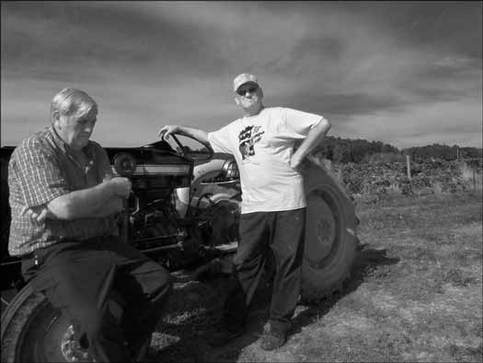
The Wiley Boys
The Wiley Boys
recent photographs
November 6 - 30, 2009
“You should a heard just what I seen.”
Bo Diddley aka Ellas MacDaniels 1956
recent photographs
November 6 - 30, 2009
“You should a heard just what I seen.”
Bo Diddley aka Ellas MacDaniels 1956
Pam Maw
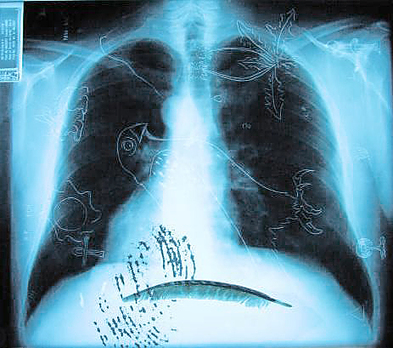
Who is your healer?
December 4 - 29, 2009
This is hardly new: Plato maintained that all art is a gift from the gods, channeled through artists who are out of their minds.¹
Pamela Maw explores the subject of healing in a variety of drawing mediums that include painting on mylar and assemblage with found objects. For the work in Who is your healer? the artist meditated and worked intuitively to have "the mind step aside to let the energy of the body steer the process in the moment”. For Maw it is about the process of creation not the product. It is not perfection she seeks, but what happens in the moment. Many of the drawings are produced using her non-dominant hand to channel a flow of imagery. They are messages from the interior.
The primitive caves, their drawings, and the spiritual realm they represent inspire Maw. It is the mystery she seeks, the energies that connect us all to the universal consciousness. Maw works from her dreams and from the dream state she mines the elements of the internal landscapes she traverses.
Pamela Maw lives in St. Catharines and was born in Washington, DC. She has lived in the Kitchener – Waterloo, Ontario area most of her life. She attended the University of Waterloo and graduated with a degree in Fine Arts. Pam went on to Queen’s University and specialized in Visual Art at Teachers’ College. Maw is an Art Specialist and was Chair of the Art Department at Mitchell District High School in Mitchell, Ontario. She has exhibited her work in juried shows in Stratford, Grimsby, and St. Catharines since 1997.
1 David Bayles and Ted Orland, Art and Fear Observations On the Perils (and Rewards) of ART MAKING (Capra Press, Santa Barbara Ca,1995) p.26
December 4 - 29, 2009
This is hardly new: Plato maintained that all art is a gift from the gods, channeled through artists who are out of their minds.¹
Pamela Maw explores the subject of healing in a variety of drawing mediums that include painting on mylar and assemblage with found objects. For the work in Who is your healer? the artist meditated and worked intuitively to have "the mind step aside to let the energy of the body steer the process in the moment”. For Maw it is about the process of creation not the product. It is not perfection she seeks, but what happens in the moment. Many of the drawings are produced using her non-dominant hand to channel a flow of imagery. They are messages from the interior.
The primitive caves, their drawings, and the spiritual realm they represent inspire Maw. It is the mystery she seeks, the energies that connect us all to the universal consciousness. Maw works from her dreams and from the dream state she mines the elements of the internal landscapes she traverses.
Pamela Maw lives in St. Catharines and was born in Washington, DC. She has lived in the Kitchener – Waterloo, Ontario area most of her life. She attended the University of Waterloo and graduated with a degree in Fine Arts. Pam went on to Queen’s University and specialized in Visual Art at Teachers’ College. Maw is an Art Specialist and was Chair of the Art Department at Mitchell District High School in Mitchell, Ontario. She has exhibited her work in juried shows in Stratford, Grimsby, and St. Catharines since 1997.
1 David Bayles and Ted Orland, Art and Fear Observations On the Perils (and Rewards) of ART MAKING (Capra Press, Santa Barbara Ca,1995) p.26